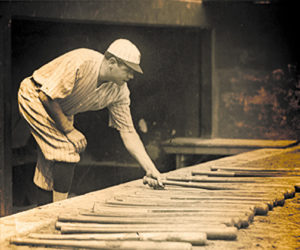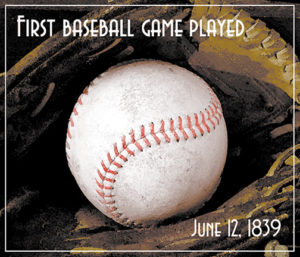 By Joe Curreri
By Joe Curreri In 1839, Abner Graves watched as his Cooperstown friend Abner Doubleday used a stick to mark out a diamond-shaped field in the dirt and explained the rules of a new game he invented named baseball. History recognizes Abner Doubleday as the father of baseball, and Abner Graves as creator of the first stitched-cover baseball.
But who made the first baseball bat, and who gave it its present shape? Who first saw the great power inherent in the timber, and foresaw the thrilling, clear, sharp sound of bat meeting ball? And why has the stamp “The Louisville Slugger” been applied to bats for so many years?
Back in 1884, John “Bud” Hillerich, an apprentice in his dad’s wood-turning shop, prolonged his lunch hour to watch his favorite local team, the Louisville Eclipses. Pete “Old Gladiator” Browning, the slugger of the Eclipses, broke his favorite bat that day, and “Bud” Hillerich watched them frantically trying to nail the broken bat together. After the game, Bud invited Browning to his dad’s shop where he could create a replacement. Selecting a sturdy ash timber, he worked it on a lathe and shaped it into a bat. Browning occasionally took test swings of the bat, and advised him to take “a little off here and a little off there.” At last Browning pronounced it “just right,” and the next day went three for three.
Browning’s bat became history’s first custom-made bat, and the Hilleriches were in the bat business. But the elder Hillerich, who had no time for baseball, could not be convinced. “I won’t allow some whim to get the best of my business judgment,” he roared. “There’s no future in supplying an article for a mere game.”
In spite of the grumblings of the “old man,” Bud stuck with bats, and when more and more minor and major league players demanded those Louisville sluggers that Bud turned out after business hours, Hillerich Sr. became convinced. He agreed to open a shop devoted entirely to bat-making. Soon the company’s famous trademark “Louisville Slugger” would be branded on each bat along with the name of the players using the bat.
 In 1905, Honus Wagner signed a contract for his autograph to be used on Louisville Slugger bats for public sale, thus beginning a now standard form of endorsement advertising.
In 1905, Honus Wagner signed a contract for his autograph to be used on Louisville Slugger bats for public sale, thus beginning a now standard form of endorsement advertising. Many of the game’s greatest players have signed with Hillerich & Bradsby and have swatted Louisville Sluggers during their Hall of Fame careers. These greats include Ty Cobb, Babe Ruth, Ted Williams, Mickey Mantle, Roger Maris, Hank Aaron and Johnny Bench. Today, Hillerich & Bradsby makes 1.5 millions bats a year. Early baseball bats were veritable “wagon tongues.” There were no restrictions as to size and weight. Pete Browning’s bat weighed 50 ounces. Pop Anson’s bat weighed 48 ounces, the same as Roger Hornsby’s bat. Frank Baker swung a club weighing 52 ounces!
Then bats got shorter and lighter. Slugger Hank Aaron’s bat was 35 inches long and weighed 33 ounces. Mantle and Maris used a medium barrel, at 35 inches and 32 ounces. The longest bat in baseball history was a 38-inch bat used by Al Simmons, who played with Philadelphia and Boston.
The longest bat in the majors was the club Dave Parker used, 36-1/2 inches long. The lightest bat is only 30 ounces, and was used by Charley Hayes of the Colorado Rockies.
The ideal timber for the modern bat is light, enduring wood with great driving qualities—ash. Manufacturers scout for trees that are 40 to 50 years in upstate New York and Pennsylvania. Each tree yields approximately 60 finished bats.
You can watch the process of making bats during free tours at Slugger Park in Jeffersonville, Indiana, which is close to the main offices. H&B also has a bat museum where baseball legends come alive. “Pete Rose’s bat shows a wide grain growth and Ted Williams wanted a narrow growth,” says Bill Williams, H&B Vice President. “Babe Ruth wanted pin knots in the barrel of his bats, thinking they made the wood stronger.”
One of the bats displayed at the plant now is complete with Babe Ruth’s characheristic notches carved for each home run he hit. Ruth had ordered 42-ounce Slugger bats when he hit 60 homers. There is also the bat used by Willie Keeler, “Hit ’em where they ain’t,” who used the smallest bat ever swung—21-1/2 inches long. Idiosyncrasies abound, it seems, among players looking for “hot” bats. Some oiled their bats, tarred them, rubbed them, even heated them. Frank Frisch hung his sluggers in a barn during the winter to cure them as one would a sausage. Del Ennis of the Phillies soaked his bat in linseed oil, making the bat “heavier but more solid in contact.” Philadelphia announcer Ritchie Ashburn said, “Pete Rose cleaned his bat with alcohol after every game, and Mike Schmidt boned his bat.”
Some players say the best thing you can do to a bat is kiss it. “Tony Pena does it all the time,” says Ashburn. “You can get fond of your bat. I kissed many bats in my time!”
The major leagues have firmly rejected the idea of switching to aluminum bats. Fans would never accept the unsatisfactory ping aluminum bats produce when hitting a ball. Such a change would have been placed in the same category as wanting to change the design of the American flag.
Pete Browning, the “old gladiator,” would no doubt club his way out of the grave in protest.
Thus it seems that the 100-plus-year old romance between wood and bat and fan is eternal. So are the excitement and thrill that vital part brings to American baseball.















Follow Us